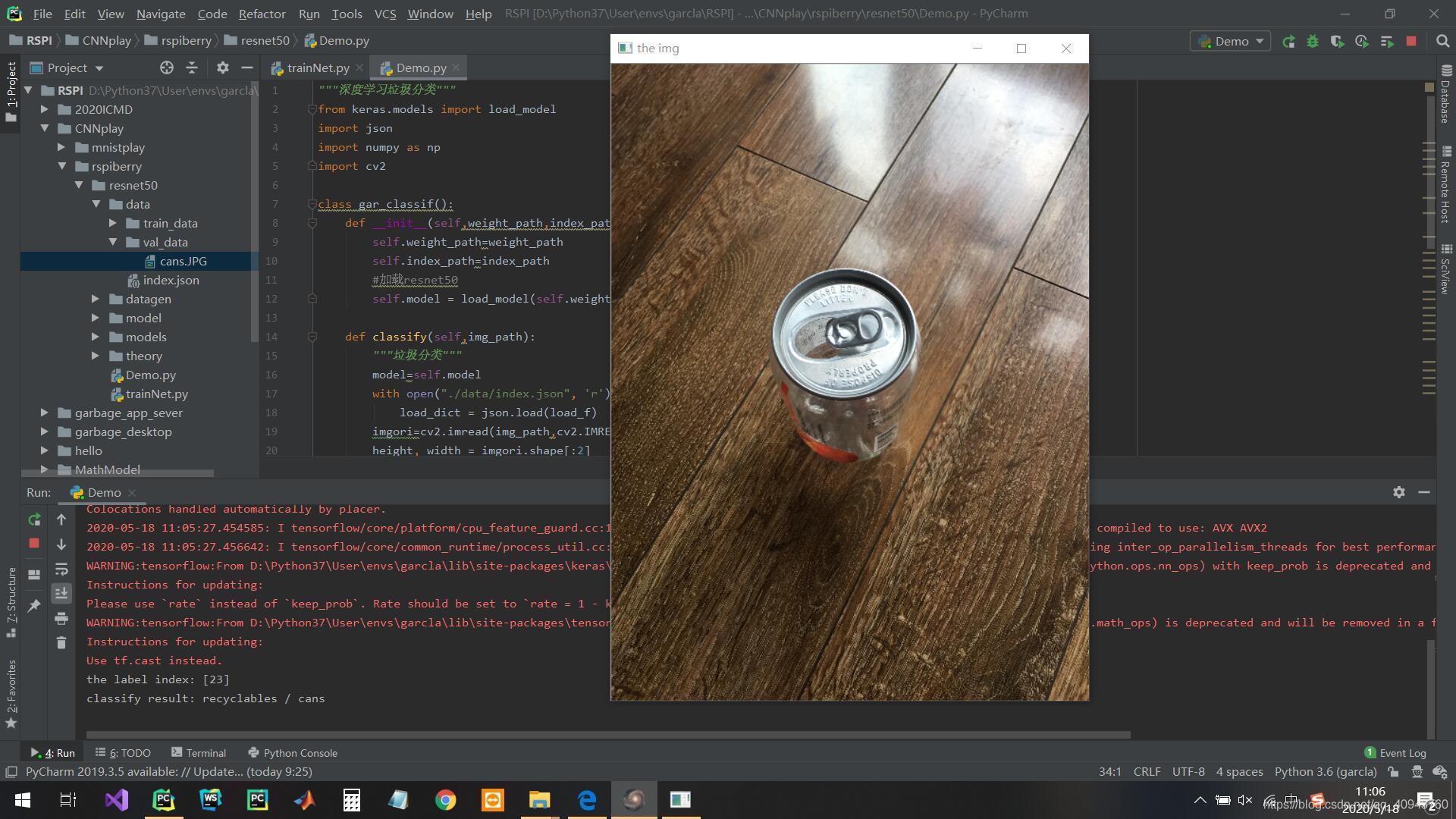介绍
这是一个基于深度学习的垃圾分类小工程,用深度残差网络构建
软件架构
- 使用深度残差网络resnet50作为基石,在后续添加需要的层以适应不同的分类任务
- 模型的训练需要用生成器将数据集循环写入内存,同时图像增强以泛化模型
- 使用不包含网络输出部分的resnet50权重文件进行迁移学习,只训练我们在5个stage后增加的层
安装教程
- 需要的第三方库主要有tensorflow1.x,keras,opencv,Pillow,scikit-learn,numpy
- 安装方式很简单,打开terminal,例如:pip install numpy -i https://pypi.tuna.tsinghua.edu.cn/simple
- 数据集与权重文件比较大,所以没有上传
- 如果环境配置方面有问题或者需要数据集与模型权重文件,可以在评论区说明您的问题,我将远程帮助您
使用说明
- 文件夹theory记录了我在本次深度学习中收获的笔记,与模型训练的控制台打印信息
- 迁移学习需要的初始权重与模型定义文件resnet50.py放在model
- 下训练运行trainNet.py,训练结束会创建models文件夹,并将结果权重garclass.h5写入该文件夹
- datagen文件夹下的genit.py用于进行图像预处理以及数据生成器接口
- 使用训练好的模型进行垃圾分类,运行Demo.py
结果演示

cans易拉罐

代码解释
在实际的模型中,我们只使用了resnet50的5个stage,后面的输出部分需要我们自己定制,网络的结构图如下:

stage5后我们的定制网络如下:
"""定制resnet后面的层""" def custom(input_size,num_classes,pretrain): # 引入初始化resnet50模型 base_model = ResNet50(weights=pretrain, include_top=False, pooling=None, input_shape=(input_size,input_size, 3), classes=num_classes) #由于有预权重,前部分冻结,后面进行迁移学习 for layer in base_model.layers: layer.trainable = False #添加后面的层 x = base_model.output x = layers.GlobalAveragePooling2D(name='avg_pool')(x) x = layers.Dropout(0.5,name='dropout1')(x) #regularizers正则化层,正则化器允许在优化过程中对层的参数或层的激活情况进行惩罚 #对损失函数进行最小化的同时,也需要让对参数添加限制,这个限制也就是正则化惩罚项,使用l2范数 x = layers.Dense(512,activation='relu',kernel_regularizer= regularizers.l2(0.0001),name='fc2')(x) x = layers.BatchNormalization(name='bn_fc_01')(x) x = layers.Dropout(0.5,name='dropout2')(x) #40个分类 x = layers.Dense(num_classes,activation='softmax')(x) model = Model(inputs=base_model.input,outputs=x) #模型编译 model.compile(optimizer="adam",loss = 'categorical_crossentropy',metrics=['accuracy']) return model网络的训练是迁移学习过程,使用已有的初始resnet50权重(5个stage已经训练过,卷积层已经能够提取特征),我们只训练后面的全连接层部分,4个epoch后再对较后面的层进行训练微调一下,获得更高准确率,训练过程如下:
class Net(): def __init__(self,img_size,gar_num,data_dir,batch_size,pretrain): self.img_size=img_size self.gar_num=gar_num self.data_dir=data_dir self.batch_size=batch_size self.pretrain=pretrain def build_train(self): """迁移学习""" model = resnet.custom(self.img_size, self.gar_num, self.pretrain) model.summary() train_sequence, validation_sequence = genit.gendata(self.data_dir, self.batch_size, self.gar_num, self.img_size) epochs=4 model.fit_generator(train_sequence,steps_per_epoch=len(train_sequence),epochs=epochs,verbose=1,validation_data=validation_sequence, max_queue_size=10,shuffle=True) #微调,在实际工程中,激活函数也被算进层里,所以总共181层,微调是为了重新训练部分卷积层,同时训练最后的全连接层 layers=149 learning_rate=1e-4 for layer in model.layers[:layers]: layer.trainable = False for layer in model.layers[layers:]: layer.trainable = True Adam =adam(lr=learning_rate, decay=0.0005) model.compile(optimizer=Adam, loss='categorical_crossentropy', metrics=['accuracy']) model.fit_generator(train_sequence,steps_per_epoch=len(train_sequence),epochs=epochs * 2,verbose=1, callbacks=[ callbacks.ModelCheckpoint('./models/garclass.h5',monitor='val_loss', save_best_only=True, mode='min'), callbacks.ReduceLROnPlateau(monitor='val_loss', factor=0.1,patience=10, mode='min'), callbacks.EarlyStopping(monitor='val_loss', patience=10),], validation_data=validation_sequence,max_queue_size=10,shuffle=True) print('finish train,look for garclass.h5')训练结果如下:
"""
loss: 0.7949 - acc: 0.9494 - val_loss: 0.9900 - val_acc: 0.8797
训练用了9小时左右
"""
如果使用更好的显卡,可以更快完成训练
最后
希望大家可以体验到深度学习带来的收获,能和大家学习很开心,更多关于深度学习的资料请关注python博客其它相关文章!
-
<< 上一篇 下一篇 >>
标签:numpy
深度学习小工程练习之tensorflow垃圾分类详解
看: 1161次 时间:2021-04-23 分类 : python教程
- 相关文章
- 2021-12-20Python 实现图片色彩转换案例
- 2021-12-20python初学定义函数
- 2021-12-20图文详解Python如何导入自己编写的py文件
- 2021-12-20python二分法查找实例代码
- 2021-12-20Pyinstaller打包工具的使用以及避坑
- 2021-12-20Facebook开源一站式服务python时序利器Kats详解
- 2021-12-20pyCaret效率倍增开源低代码的python机器学习工具
- 2021-12-20python机器学习使数据更鲜活的可视化工具Pandas_Alive
- 2021-12-20python读写文件with open的介绍
- 2021-12-20Python生成任意波形并存为txt的实现
-
搜索
-
-
推荐资源
-
Powered By python教程网 鲁ICP备18013710号
python博客 - 小白学python最友好的网站!